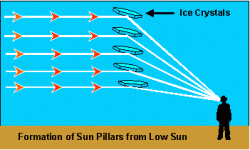

(Appologies to www.islandnet.com/~see/weather/eyes/pillars.htm .)
Following are two English commentaries of the playing of Louis Drouet (1792–1873). He was born in Amsterdam, to a French refugee father and a Dutch mother.
Both comments refer, I believe, to Drouet's performances in London in 1829. He was using a French flute at that time. The descriptions match some of my ideas of the sound and characteristics of French simple system flutes, and the second review conveys a perhaps more typical English opinion of these flutes.
The comments are reprinted in R. S. Rockstro's Treatise on the Flute of 1889, where I found them.
The first is attributed to W. N. James, 1829.
"It is impossible to imagine anything so positively beautiful as the tone of M. Drouet; it must be heard to be appreciated. If tone were visible to the eye, we would liken that which he produces to pillars of crystal in the sunshine, so clear, so transparent, so brilliant, and so solid withal, that it seems the very essence of tone, without a cloud or particle of alloy in its composition. . . . His execution is the very beau ideal of perfection, it is quite miraculous."


The second quote is from the Quarterly Musical Magazine.
"Mr. Drouet's talents as a performer deservedly received the most brilliant applause on his arrival in this country, but it could not escape the attention of the intelligent observer that the embouchure, as well as the bore of his flute, was made exceedingly small for the purpose of giving brilliancy to the upper notes, on the display of which, he manifestly rested the principal attraction of his performance. This construction of the instrument, however, totally destroyed all its lower rich, mellow tones, and deprived the performer of those contrasts which are so important. . . . This gave a monotonous effect to all he did. The delight, and we may add, the astonishment with which his first performance was heard, was diminished at the second or third, and at length a talent so calculated to excite admiration was regarded with indifference. His method of articulation, though resembling double-tongueing, was not really so, but was some modification peculiar to himself, which gave him the power of the most brilliant, distinct and rapid execution that can be conceived, and to which he seemed to think every other excellence worthily sacrificed. His intonation was perfect, but there was no volume of tone, and the absence of the richer tones of the flute rendered him unable to play an adagio with anything like the effect which such a movement requires . . . By the manner in which he executed his passages, one would be inclined to think that he had originally practised on a one-keyed flute, for in slow execution the defects of his fingering were very perceptible. His amazing facility in rapid passages concealed these defects, but we are fully persuaded that had he performed an adagio in a flat key, the imperfections would have been manifest to the most cursory observer."
Rockstro says that Drouet played an "ordinary" eight-key flute on his first visit to London (1817–1819), but that by the time of his Méthode of 1827, "he played on a flute of the French model, with the keys mounted on pillars". Probably these were pillars of silver, and not crystal in the sunshine.
In the preface to the introduction of the 1830 English edition of his Method, Drouet recommends that the beginner commence "at once with an eight-keyed instrument", rather than starting with a one or a four-keyed flute.